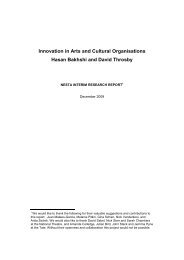Rumbling on performativity_Frits Simon
Rumbling on performativity_Frits Simon
Rumbling on performativity_Frits Simon
Create successful ePaper yourself
Turn your PDF publications into a flip-book with our unique Google optimized e-Paper software.
interacti<strong>on</strong>s and their c<strong>on</strong>structive impact. An organizati<strong>on</strong> is approached as a temporarily<br />
social c<strong>on</strong>structi<strong>on</strong>.<br />
The c<strong>on</strong>versati<strong>on</strong>al interacti<strong>on</strong>s, in which an organizati<strong>on</strong> is established, should not be<br />
idealized according to some sort of utopian norm. In the interacti<strong>on</strong>s negotiati<strong>on</strong>s<br />
about what is real are c<strong>on</strong>stantly going <strong>on</strong>. These interacti<strong>on</strong>s are loaded with power<br />
differences. Due to the interdependency of the pers<strong>on</strong>s involved, mutual relati<strong>on</strong>s fluctuate<br />
all the time. Thus the interacti<strong>on</strong>s are neither interpreted as <strong>on</strong>e-sided or topdown<br />
affairs nor as an idealized communicative process. Point of departure is the<br />
working of the micro-politics of power (Foucault, 1976) incorporated in the mutual<br />
gestures (Mead, 1934) of the pers<strong>on</strong>s involved. In the fluctuating and interdependent<br />
interacti<strong>on</strong>s emerges what sort of organizati<strong>on</strong>al reality is accepted for the time being.<br />
However, the temporality of the organizati<strong>on</strong>al reality is not to be interpreted as if<br />
every day this reality is built up from scratch. Within a complex resp<strong>on</strong>sive processapproach<br />
<strong>on</strong>e speaks of transformative causality (Stacey, 2010; Stacey and Griffin,<br />
2005) to catch the idea of c<strong>on</strong>tinuity and temporality at the same time. Basically the<br />
idea is that the past is not present in the present in a deterministic way, but as the<br />
point of departure for the present. As point of departure the past has caused the<br />
present - human beings are historically and socially entrenched - but due to the<br />
<strong>on</strong>going interacti<strong>on</strong>s different pasts emerge every day. Within a complex resp<strong>on</strong>sive<br />
process-approach it is argued that in the living present the existing social reality is<br />
c<strong>on</strong>stantly sustained and transformed.<br />
The foundati<strong>on</strong>al c<strong>on</strong>cepts in a nutshell: complexity, resp<strong>on</strong>siveness and process<br />
To my idea transformative causality can be taken as a suitable expressi<strong>on</strong> of the<br />
c<strong>on</strong>fluence of c<strong>on</strong>cepts which are foundati<strong>on</strong>al for a complex resp<strong>on</strong>sive process-approach.<br />
The foundati<strong>on</strong>al c<strong>on</strong>cepts of a complex resp<strong>on</strong>sive process-approach originated<br />
predominantly from complexity sciences (Prigogine, 1996; Prigogine and Stengers,<br />
1988), figurati<strong>on</strong>al sociology (Elias, 1969, 1970) and interacti<strong>on</strong>ist psychology from a<br />
pragmatist’s point of view (Mead, 1932, 1934). I give a short introducti<strong>on</strong> of the c<strong>on</strong>cepts,<br />
in the coming chapters these c<strong>on</strong>cepts will help to develop some understanding<br />
about what is happening in organizati<strong>on</strong>al life.<br />
Complexity<br />
In the 1970s and 1980s according to Stacey (2007) complexity sciences started to<br />
influence discussi<strong>on</strong>s in the natural sciences by introducing c<strong>on</strong>cepts as chaos, dissipative<br />
structures, strange attractors and n<strong>on</strong>-linearity. Instead of a predictable, stable<br />
and mechanical picture of nature a picture of perpetual change, unpredictability,<br />
self-organizati<strong>on</strong>, emergence and diversity was painted. A basic c<strong>on</strong>tenti<strong>on</strong> is that, although<br />
initial c<strong>on</strong>diti<strong>on</strong>s may be known, to predict how things will evolve is not possible.<br />
The flaws in weather forecasts are a useful illustrati<strong>on</strong> of the unpredictability. Due<br />
to tiny variati<strong>on</strong>s in the initial c<strong>on</strong>diti<strong>on</strong>s unpredictable patterns evolve in the l<strong>on</strong>g run,<br />
which cannot be reduced to what preceded them. A process is irreversible. The noti<strong>on</strong><br />
28



